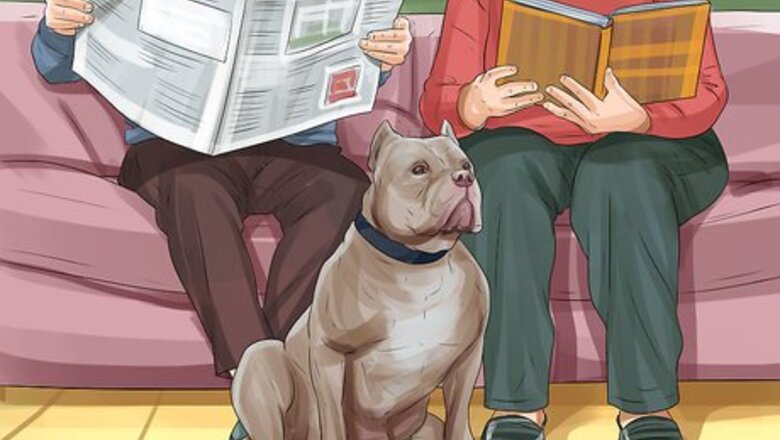
views
Deciding to Adopt a Pit Bull

Assess whether a pit bull would fit well in your family. When deciding to get a pit bull, you should do a little bit of research about the breed and determine whether they are a good fit for your lifestyle and living situation. Pit bulls are generally very smart, trainable dogs that can be loving and tender companions. If they are given consistent training, exercise, and care, they can be wonderful pets for families and individuals. Because some pit bulls have been mistreated and trained to fight, they have earned a reputation for being aggressive. While dog attacks are a real problem, pit bulls should be evaluated on an individual basis, not just for their breed.

Decide what age pit bull you would like. Once you know you want a pit bull, determine what age would be best for you. Some people want to get a puppy because they can begin training them very young and bond with them from a young age. Some people want an older dog because they won't have to do basic training with them and can avoid the work of raising the dog. You decide which scenario is right for you. One benefit of adopting an adult dog is you will know what its personality is like. When adopting a puppy, you won't know its adult personality until you have had it for a few years.

Research any local laws that restrict pit bull ownership. In some locations there are laws or regulations that either ban pit bull ownership or apply restrictions around having a pit bull. Before bringing a pit bull home, review local laws so that you don't end up having to return the dog. Local restrictions can typically be found on your local government's website. Do an internet search that contains your town's name, "pitbull," and "restrictions."

Determine whether you can have a pit bull in your home. If you are renting your home or live in a place with a homeowners’ association (HOA), there may be restrictions about having pets in general and pit bulls in particular. Check with your landlord or HOA about whether pets are allowed in your home and if there are any breed restrictions you should know about. It's important to get the adoption cleared with your landlord because if you are a renter, many rescue organizations and shelters require a letter from your landlord that explicitly says a pit bull is allowed in the residence. It's also important to check with your home insurance before adopting a pit bull. Some homeowner and renter insurance policies don’t cover specific breeds.
Finding a Pit Bull to Adopt

Look for available pit bulls online. Most animal rescue organizations and animal shelters list all of their adoptable pets online. Do a general internet search that includes your city, "pit bull," "adoption," and "puppy," if applicable. You can also look at specific websites that combine listings from a variety of shelters and rescue organizations all in one place, such as Pet Finder. Once you identify websites that advertise pit bulls in your area, even if they don't have any available right now, make note of the websites. This will allow you to check them on a regular basis to see when new dogs become available.

Contact local rescue organizations. If you find a local rescue organization during your internet searches or through word of mouth, you should contact them. Tell them what you are looking for and ask them to contact you if an appropriate dog becomes available. Not all rescues will accommodate this request, but it doesn't hurt to try. Also, if you have found an available dog online but you have specific questions about them, contact the rescue or shelter.

Evaluate available pit bulls. Once you have found listings for pit bulls, you should make a list of those that you are interested in. Weight them against one another, and narrow them down to a few that fit your needs. Make sure to keep your ideal parameters in mind throughout the process, even when faced with cute puppy dog eyes. Wait for a cute dog that is right for your lifestyle, home, and family.

Visit pit bulls available for adoption. Once you have picked 1 or more pit bulls that might be right for you, you should meet them. Spend some time with them so you can evaluate their temperament and see if they are a good fit for you. This time also gives you a chance to assess their general health and appearance. In most cases, you want to look for a dog that is not too shy or scared but also not aggressive. A dog that is a bit timid but wagging its tail may just be temporarily timid due to its environment, but a dog that growls at you may need a lot of training and care to overcome its issues. In some cases, you will need to apply to an organization before they let you meet their dogs in person. If this is the case, fill out the application and wait to be approved before visiting the dog. Just because you have been approved, that doesn't mean you need to adopt the dog you visit.
Completing Your Adoption

Apply to adopt a pit bull. Once you have found a dog that you want, you will need to fill out an application to adopt it. This application may vary depending on the shelter or rescue, but typically includes basic informational questions, such as your name, address, and phone number, as well as specific questions about how the dog will be cared for, including how you will discipline the dog when it misbehaves. In most cases, the application process is not just a formality. Shelters and rescues want to find good, appropriate homes for their dogs so that the dogs will have a supportive and caring life-long home. This means that you should answer all questions honestly and should put some care into your answers.

Complete the screening process. Once you have applied for a dog there is usually a screening process you will have to go through with a shelter or a rescue. This typically includes a short interview, either in person or over the phone, where you will need to answer questions about how you will care for the dog and what kind of living conditions you can provide for it. Common questions include ones about your yard space, what kind of training you will provide, whether you have small children in the home, and if you have the financial means to care for a dog properly.

Prepare to bring your new dog home. You will need to buy supplies and set up space for the dog in your home. Make sure you have food, bowls for food and water, a collar, a leash, bedding, grooming supplies, waste bags, and toys for the dog. You will want to dog proof your home. This means putting items that could get eaten or destroyed out of reach, especially items that could be hazardous to the dog. It may also mean separating a space where the dog can play and lounge from areas where you want to control its movements and actions. When preparing to bring a new dog home, you should also make an appointment for a preliminary veterinary appointment to get the dog's health assessed. You may also want to set up a training session for your new dog, so that you can start training it right away.

Pay fees and bring your new dog home. Once you have been approved for adoption and have prepared for your new family member, it's time to bring your new pet home. Pay any adoption fees that are required, transport the dog in your car, and then introduce it to its new home. Adoption fees can vary depending on the desirability of the dog and the organization that you are adopting from. Depending on the specific dog, it may go with you willingly and enthusiastically or it may be a little hesitant. No matter what, just be patient with it as it adjusts to its new family and new surroundings.




















Comments
0 comment